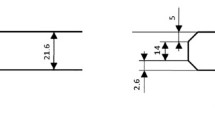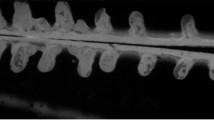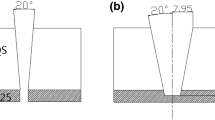Abstract
High-frequency induction welding (HFIW) is among the most commonly used methods for producing roll formed pipes. In this paper, weld quality is evaluated through examining the weld properties, in order to obtain the effect of edge preparation on improvement of weld quality. Temperature distribution in the weld zone is studied through the groove shape of the weld joint, and the other parameters such as current, frequency, and linear speed, considered constant, are equal to 1400 A, 150 kHz, and 25 m/min respectively. The mechanical and metallurgical properties of the weld metal were evaluated by tensile test and metallography. The appropriate temperature distribution resulted from modifying the shape of the connecting edges, leading to a reduction of 27% in the mean size of the grains in the weld zone. The results also show that by increasing the temperature of welding, the heat-affected area expands and the other areas decrease. When the results of the metallography tests of the weld zone were compared, a more uniform weld width was observed in the welded specimens with modified edges. The results also showed an 18% decrease in the weld width in specimens, compared with the specimens without edge preparation.

















Similar content being viewed by others
References
Okabe T, Yasuda K, Nakata K (2014) Dynamic observations of welding phenomena and finite element analysis in high frequency electric resistance welding. Quarterly Journal of The Japan Welding Society 32(3):156–163
Okabe T, Iizuka Y, Igi S (2014) High reliability technology of the weld zone of high-frequency electric resistance welding linepipes. JFE Technical Report 34:77–83
Saito M, Kasahara H, Tominaga H, Watanabe S (1986) Theoretical analysis of current distribution in electric resistance welding. Transactions of the Iron and Steel Institute of Japan 26(5):461–467
Nikanorov A, Baake E, Neumeyer J (2015) Numerical simulation and investigation of high frequency tube welding process. Appl Mech Mater 698:245–250
Shunsuke T, Sota G, Takatoshi O, Hideto K, Satoshi L (2015) Metallurgical design and performance of high-frequency electric resistance welded linepipe with high-quality weld seam suitable for extra-low-temperature services. Journal of Offshore Mechanics and Arctic Engineering 137:1–11
choi J, chang Y, kim C, OH J, kim Y (2004) Penetrator formation mechanisms during high-frequency electric resistance welding. Weld J 27–31
Kim T, Park Y, Sung K, Kang M, Kim C, lee C et al (2007) Estimation of weld quality in high-frequency electric resistance welding with image processing. Weld J 7:1–9
Kim H-J, Youn S-K (2008) Three dimensional analysis of high frequency induction welding of steel pipes with impeder. J Manuf Sci Eng 130(3):031005–031007
han Y, yu E (2012) Numerical analysis of a high-frequency induction welded pipe. Weld J :270–7
Choong-Myeong K, Jung-Kyu K (2009) The effect of electromagnetic forces on the penetrator formation during high-frequency electric resistance welding. J Mater Process Technol 209:838–846
Sung-Soo E, Min-Hyun C, Ki-Hong K, Hyun-Seung L (2012) Development of optimum welding heat input device based on welding frequency and spark detection. Proceedings of the 2012 9th international pipeline conference: 24–28
Forzan M, Garbin M, Dughiero F, Sieni E, Pozza C (2011) A 3D numerical FEM model for the simulation of induction welding of tubes. COMPEL - The international journal for computation and mathematics in electrical and electronic engineering 30(5):1570–1581
Baumer R, Adonyi Y (2009) Transient high-frequency welding simulations of dual-phase steels 88: 193–201
Kasaei MM, Moslemi Naeini H, Azizi Tafti R, Tehrani MS (2014) Prediction of maximum initial strip width in the cage roll forming process of ERW pipes using edge buckling criterion. J Mater Process Technol 214(2):190–199
Santana IJ, Paulo B, Modenesi PJ (2006) High frequency induction welding simulating on ferritic stainless steels. J Mater Process Technol 179:225–230
Yu EL, Han Y, Fan Y, Zhao Y (2010) Simulation of coupling of electromagnetic and thermal fields for process of high-frequency induction heating of HFW pipe. Hanjie Xuebao/Transactions of the China Welding Institution 31:5–8
Choong K, Jung-Kyu K (2009) The effect of heat input on the defect phases in high frequency electric resistance welding. Met Mater 1:141–148
Udhayakumar T, Mani E (2017) Effect of HF welding process parameters and post heat treatment in the development of micro alloyed HSLA steel tubes for torsional application. J Mater Sci Eng 6:1–8
Standard Test Methods for Tension Testing of Metallic Materials (2007) ASTM Standard
Yan P, Gungor OE, Thibaux P, Liebeherr M, Bhadeshia HKDH (2011) Tackling the toughness of steel pipes produced by high frequency induction welding and heat-treatment. Mater Sci Eng A 528(29):8492–8499
Author information
Authors and Affiliations
Corresponding author
Additional information
Publisher’s note
Springer Nature remains neutral with regard to jurisdictional claims in published maps and institutional affiliations.
Rights and permissions
About this article
Cite this article
Ghaffarpour, M., Akbari, D., Moslemi Naeeni, H. et al. Improvement of the joint quality in the high-frequency induction welding of pipes by edge modification. Weld World 63, 1561–1572 (2019). https://doi.org/10.1007/s40194-019-00779-0
Received:
Accepted:
Published:
Issue Date:
DOI: https://doi.org/10.1007/s40194-019-00779-0




